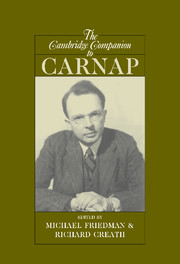Book contents
- Frontmatter
- Introduction: Carnap’s revolution in philosophy
- 1 Carnap’s intellectual development
- 2 Geometrical leitmotifs in Carnap’s early philosophy
- 3 Carnap and Frege
- 4 Carnap and Husserl
- 5 Carnap, Russell, and the external world
- 6 The Aufbau and the rejection of metaphysics
- 7 Carnap and the Vienna Circle: rational reconstructionism refined
- 8 Carnap and modern logic
- 9 Tolerance and logicism: logical syntax and the philosophy of mathematics
- 10 Carnap’s quest for analyticity: the Studies in Semantics
- 11 Carnap on the rational reconstruction of scientific theories
- 12 Carnap on probability and induction
- 13 Carnapian pragmatism
- 14 Quine’s challenge to Carnap
- Bibliography
- Index
12 - Carnap on probability and induction
Published online by Cambridge University Press: 28 April 2008
- Frontmatter
- Introduction: Carnap’s revolution in philosophy
- 1 Carnap’s intellectual development
- 2 Geometrical leitmotifs in Carnap’s early philosophy
- 3 Carnap and Frege
- 4 Carnap and Husserl
- 5 Carnap, Russell, and the external world
- 6 The Aufbau and the rejection of metaphysics
- 7 Carnap and the Vienna Circle: rational reconstructionism refined
- 8 Carnap and modern logic
- 9 Tolerance and logicism: logical syntax and the philosophy of mathematics
- 10 Carnap’s quest for analyticity: the Studies in Semantics
- 11 Carnap on the rational reconstruction of scientific theories
- 12 Carnap on probability and induction
- 13 Carnapian pragmatism
- 14 Quine’s challenge to Carnap
- Bibliography
- Index
Summary
INTRODUCTION
This chapter discusses Carnap's work on probability and induction, using the notation and terminology of modern mathematical probability, viewed from the perspective of the Bayesian or subjective school of probability. Carnap initially used a logical notation and terminology that made his work accessible and interesting to a generation of philosophers, but it also limited its impact in other areas such as statistics, mathematics, and the sciences. Using the notation of modern mathematical probability is not only more natural, but it also makes it far easier to place Carnap's work alongside the contributions of such other pioneers of epistemic probability as Frank Ramsey, Bruno de Finetti, I. J. Good, L. J. Savage, and Richard Jeffrey.
Carnap's interest in logical probability was primarily as a tool, a tool to be used in understanding the quantitative confirmation of a hypothesis based on evidence and, more generally, in rational decision-making. The resulting analysis of induction involved a two-step process: one first identified a broad class of possible confirmation functions (the regular c-functions), and then identified either a unique function in that class (early Carnap) or a parametric family (later Carnap) of specific confirmation functions. The first step in the process put Carnap in substantial agreement with subjectivists such as Ramsey and de Finetti; it is the second step, the attempt to limit the class of probabilities still further, that distinguishes Carnap from his subjectivist brethren.
- Type
- Chapter
- Information
- The Cambridge Companion to Carnap , pp. 273 - 294Publisher: Cambridge University PressPrint publication year: 2007
- 1
- Cited by

